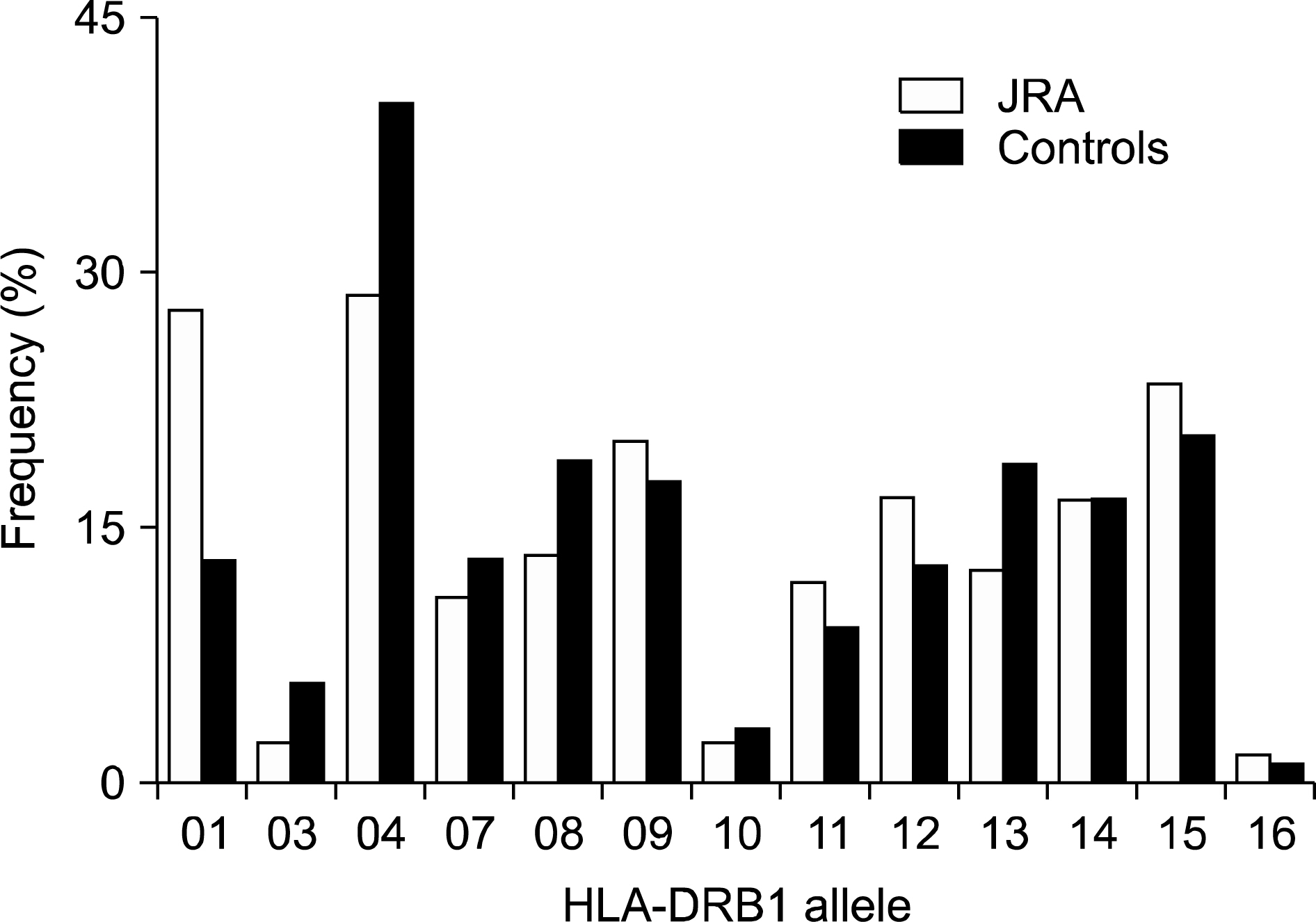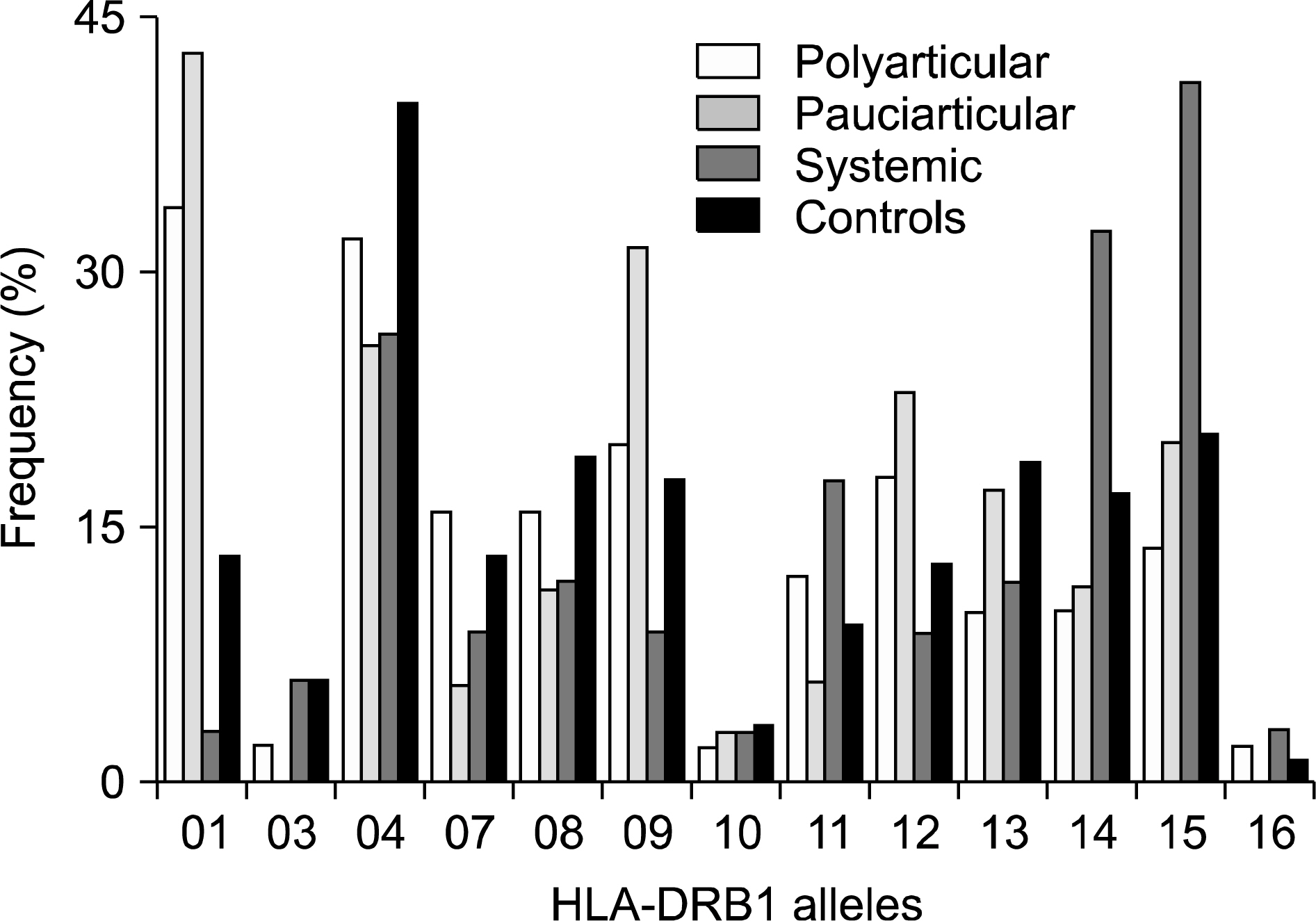J Rheum Dis.
2014 Aug;21(4):182-186. 10.4078/jrd.2014.21.4.182.
Human Leukocyte Antigen-DRB1 Associations in Korean Juvenile Rheumatoid Arthritis
- Affiliations
-
- 1Department of Pediatric, Hallym University Sacred Heart Hospital, Anyang, Korea. kwangnamkim@naver.com
- 2Department of Adolescent Medicine, Hallym University Sacred Heart Hospital, Anyang, Korea.
- 3Department of Laboratory Medicine, Hallym University Sacred Heart Hospital, Anyang, Korea.
- KMID: 2222958
- DOI: http://doi.org/10.4078/jrd.2014.21.4.182
Abstract
OBJECTIVE
The aim of this study is to investigate the association of different subgroups of juvenile rheumatoid arthritis (JRA) with human leukocyte antigen (HLA) class II DR alleles.
METHODS
One hundred and nineteen Korean juvenile rheumatoid arthritis patients were classified as HLA-DRB1 allele. To assess the frequency, phenotype frequencies of all JRA cases and each subtypes were compared to those of 485 adult controls.
RESULTS
HLA-DRB1*01 was associated with increased risk of JRA. Furthermore, DRB1*01 was associated with polyarticular JRA and pauciarticular JRA. The frequencies of DRB1*14 and DRB1*15 were higher in systemic JRA patients than the controls.
CONCLUSION
The data of this study on Korean children with JRA suggests that HLA-DRB1*01 was associated with the susceptibility of JRA. The study should be extended to include larger numbers of patients.
MeSH Terms
Figure
Cited by 2 articles
-
Association of Human Leukocyte Antigen-DRB1 with Juvenile Idiopathic Arthritis
Hye-Soon Lee
J Rheum Dis. 2014;21(5):225-227. doi: 10.4078/jrd.2014.21.5.225.Prevalence, Risk Factors, and Expression of Human Leukocyte Antigen-DRB1 in Juvenile Idiopathic Arthritis-associated Uveitis
Jin Kyu Pyo, Sol Lee, Kwang Nam Kim
J Rheum Dis. 2018;25(1):58-64. doi: 10.4078/jrd.2018.25.1.58.
Reference
-
1. Grom AA, Giannini EH, Glass DN. Juvenile rheumatoid arthritis and the trimolecular complex (HLA, T cell receptor, and antigen). Differences from rheumatoid arthritis. Arthritis Rheum. 1994; 37:601–7.2. Nepom B. The immunogenetics of juvenile rheumatoid arthritis. Rheum Dis Clin North Am. 1991; 17:825–42.
Article3. Brewer EJ Jr, Bass J, Baum J, Cassidy JT, Fink C, Jacobs J, et al. Current proposed revision of JRA Criteria. JRA Criteria Subcommittee of the Diagnostic and Therapeutic Criteria Committee of the American Rheumatism Section of The Arthritis Foundation. Arthritis Rheum. 1977; 20(2 Suppl):195–9.4. Petty RE, Southwood TR, Baum J, Bhettay E, Glass DN, Manners P, et al. Revision of the proposed classification criteria for juvenile idiopathic arthritis: Durban, 1997. J Rheumatol. 1998; 25:1991–4.5. Leak AM, Woo P. Juvenile chronic arthritis, chronic iridocyclitis, and reactivity to histones. Ann Rheum Dis. 1991; 50:653–7.
Article6. Glass DN, Giannini EH. Juvenile rheumatoid arthritis as a complex genetic trait. Arthritis Rheum. 1999; 42:2261–8.
Article7. Haas JP, Truckenbrodt H, Paul C, Hoza J, Scholz S, Albert ED. Subtypes of HLA-DRB1*03, *08, *11, *12, *13 and *14 in early onset pauciarticular juvenile chronic arthritis (EOPA) with and without iridocyclitis. Clin Exp Rheumatol. 1994; 12(Suppl 10):S7–14.8. Ploski R, Vinje O, Rønningen KS, Spurkland A, Sørskaar D, Vartdal F, et al. HLA class II alleles and heterogeneity of juvenile rheumatoid arthritis. DRB1*0101 may define a novel subset of the disease. Arthritis Rheum. 1993; 36:465–72.9. Garavito G, Yunis EJ, Egea E, Ramirez LA, Malagón C, Iglesias A, et al. HLA-DRB1 alleles and HLA-DRB1 shared epitopes are markers for juvenile rheumatoid arthritis subgroups in Colombian mestizos. Hum Immunol. 2004; 65:359–65.
Article10. Lee KW, Oh DH, Lee C, Yang SY. Allelic and hap-lotypic diversity of HLA-A, -B, -C, -DRB1, and -DQB1 genes in the Korean population. Tissue Antigens. 2005; 65:437–47.
Article11. Olerup O, Zetterquist H. HLA-DR typing by PCR amplification with sequence-specific primers (PCR-SSP) in 2 hours: an alternative to serological DR typing in clinical practice including donor-recipient matching in cadaveric transplantation. Tissue Antigens. 1992; 39:225–35.
Article12. Kam MH, Jeffery LB. Handbook of HLA-typing Techniques. p. 432. Boca Raton: CRC Press;1993.13. Alsaeid K, Haider MZ, Kamal H, Srivastva BS, Ayoub EM. Prevalence of human leukocyte antigen (HLA) DRB1 alleles in Kuwaiti children with juvenile rheumatoid arthritis. Eur J Immunogenet. 2002; 29:1–5.
Article14. Stastny P, Fernandez-Viña M, Cerna M, Havelka S, Ivaskova E, Vavrincova P. Sequences of HLA alleles associated with arthritis in adults and children. J Rheumatol Suppl. 1993; 37:5–8.15. Miller ML, Aaron S, Jackson J, Fraser P, Cairns L, Hoch S, et al. HLA gene frequencies in children and adults with systemic onset juvenile rheumatoid arthritis. Arthritis Rheum. 1985; 28:146–50.
Article16. Thomson W, Barrett JH, Donn R, Pepper L, Kennedy LJ, Ollier WE, et al. British Paediatric Rheumatology Study Group. Juvenile idiopathic arthritis classified by the ILAR criteria: HLA associations in UK patients. Rheumatology (Oxford). 2002; 41:1183–9.
Article17. Pratsidou-Gertsi P, Kanakoudi-Tsakalidou F, Spyropoulou M, Germenis A, Adam K, Taparkou A, et al. Nationwide collaborative study of HLA class II associations with distinct types of juvenile chronic arthritis (JCA) in Greece. Eur J Immunogenet. 1999; 26:299–310.
Article18. Okubo H, Itou K, Tanaka S, Watanabe N, Kashiwagi N, Obata F. Analysis of the HLA-DR gene frequencies in Japanese cases of juveniles rheumatoid arthritis and rheumatoid arthritis by oligonucleotide DNA typing. Rheumatol Int. 1993; 13:65–9.
Article19. Nepom BS, Nepom GT, Mickelson E, Schaller JG, Antonelli P, Hansen JA. Specific HLA-DR4-associated histocompatibility molecules characterize patients with seropositive juvenile rheumatoid arthritis. J Clin Invest. 1984; 74:287–91.
Article
- Full Text Links
- Actions
-
Cited
- CITED
-
- Close
- Share
- Similar articles
-
- Association of Human Leukocyte Antigen-DRB1 with Juvenile Idiopathic Arthritis
- Clinical significance of rheumatoid factor in juvenile rheumatoid arthritis
- Erratum: Table 1, Table 3: Human Leukocyte Antigen-DRB1 Associations in Korean Juvenile Rheumatoid Arthritis
- Clinical observation on juvenile theumatoid arthritis
- Potential Role of Epstein-Barr Virus in Juvenile Rheumatoid Arthritis



